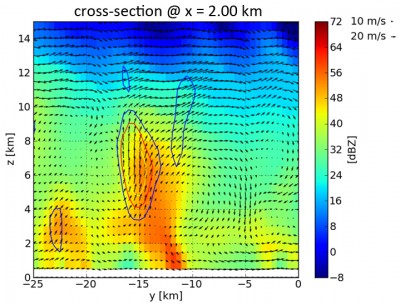Convective Vertical Velocity Data Ready for Evaluation
Published: 4 October 2012

The new Convective Vertical Velocity (CONVV) value-added product uses observations from Doppler weather radars and other instruments to produce a best estimate of convective vertical velocity. This evaluation product is available for a few key cases during the Midlatitude Continental Convective Clouds Experiment field campaign at the ARM Southern Great Plains site.
Convective processes play an important role in Earth’s energy balance by distributing heat and moisture throughout the atmosphere. In particular, vertical air motions associated with these processes are inherently linked to the life cycle of these convective systems and are therefore directly tied to their energy budget. However, direct measurements of vertical air motions (e.g., in situ aircraft observations) are sparse, making it difficult to compare them with numerical model output, which relies on convective parameterization schemes that have yet to be extensively validated with direct or indirect measurements.
A Doppler weather radar, though unable to directly measure vertical velocity, is able to observe mesoscale storm structure. Using data assimilation techniques, observations from single or multiple Doppler weather radars can be combined with other observations (e.g., a radiosonde profile) to produce a best estimate of the mesoscale atmospheric kinematics. The CONVV VAP uses mapped radar-derived and reflectivity factor, as well as radial velocity, as inputs to a variational algorithm to retrieve three-dimensional three-component (zonal, meridional, and vertical) air motions.
More information on CONVV is available at the VAP web page. Currently, CONVV is in an evaluation period, and any comments or suggestions are welcome. Please send your feedback to Scott Collis, ARM Precipitation Radar Instrument Translator. To access these data, log in to the Data Archive. (Go here to request an account.)
The ARM Climate Research Facility is a DOE Office of Science user facility. The ARM Facility is operated by nine DOE national laboratories, including .
Keep up with the Atmospheric Observer
Updates on ARM news, events, and opportunities delivered to your inbox
ARM User Profile
ARM welcomes users from all institutions and nations. A free ARM user account is needed to access ARM data.


















